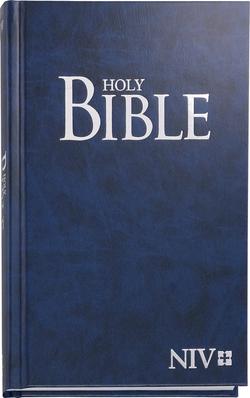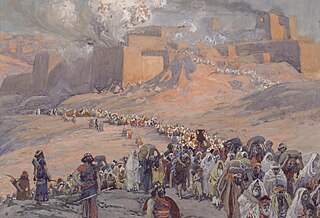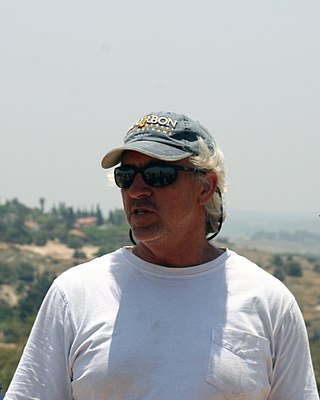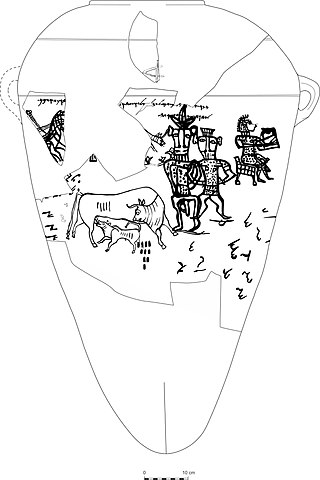Related Research Articles

The Kingdom of Judah was an Israelite kingdom of the Southern Levant during the Iron Age. Centered in the highlands to the west of the Dead Sea, the kingdom's capital was Jerusalem. It was ruled by the Davidic line for four centuries. Jews are named after Judah, and primarily descend from people who lived in the region.

The New International Version (NIV) is a translation of the Bible into contemporary English. Published by Biblica, the complete NIV was released on October 27, 1978 with a minor revision in 1984 and a major revision in 2011. The NIV relies on recently-published critical editions of the original Hebrew, Aramaic, and Greek texts.

The Israelites were a Hebrew-speaking ethnoreligious group consisting of tribes that inhabited much of Canaan during the Iron Age.

The Babylonian captivity or Babylonian exile was the period in Jewish history during which a large number of Judeans from the ancient Kingdom of Judah were forcibly relocated to Babylonia by the Neo-Babylonian Empire. The deportations occurred in multiple waves: After the siege of Jerusalem in 597 BCE, around 7,000 individuals were deported to Mesopotamia. Further deportations followed the destruction of Jerusalem and Solomon's Temple in 587 BCE.

According to the Hebrew Bible, the tribe of Judah was one of the twelve Tribes of Israel, named after Judah, the son of Jacob. Judah was the first tribe to take its place in the Land of Israel, occupying its Southern part. Jesse and his sons, including King David, belonged to this tribe.

Shechem, also spelled Sichem was an ancient city in the southern Levant. Mentioned as a Canaanite city in the Amarna Letters, it later appears in the Hebrew Bible as the first capital of the Kingdom of Israel following the split of the United Monarchy. According to Joshua 21:20–21, it was located in the tribal territorial allotment of the tribe of Ephraim. Shechem declined after the fall of the northern Kingdom of Israel. The city later regained its importance as a prominent Samaritan center during the Hellenistic period.

Yehud is a city in the Central District of Israel that is part of the joint municipality of Yehud-Monosson. In 2007, the city's population stood at approximately 30,000 people.

Gerar was a Philistine town and district in what is today south central Israel, mentioned in the Book of Genesis and in the Second Book of Chronicles of the Hebrew Bible.

Geshur was a territory in the ancient Levant mentioned in the early books of the Hebrew Bible and possibly in several other ancient sources, located in the region of the modern-day Golan Heights. Some scholars suggest it was established as an independent city-state from the middle of the tenth century BCE, maintaining its autonomy for about a century until it was annexed in the third quarter of the ninth century by Hazael, the king of Aram-Damascus.

The return to Zion is an event recorded in Ezra–Nehemiah of the Hebrew Bible, in which the Jews of the Kingdom of Judah—subjugated by the Neo-Babylonian Empire—were freed from the Babylonian captivity following the Persian conquest of Babylon. In 539 BCE, the Persian king Cyrus the Great issued the Edict of Cyrus allowing the Jews to return to Jerusalem and the Land of Judah, which was made a self-governing Jewish province under the new Persian Empire.

The Yehud coinage is a series of small silver coins bearing the Aramaic inscription Yehud. They derive their name from the inscription YHD (𐤉𐤄𐤃), "Yehud", the Aramaic name of the Achaemenid Persian province of Yehud; others are inscribed YHDH, the same name in Hebrew. The minting of Yehud coins commenced around the middle of the fourth century BC, and continued until the end of the Ptolemaic period.
Johanan, son of Joiada, was the fifth High Priest of the Temple in Jerusalem after it was rebuilt after the end of the Babylonian captivity. His reign is estimated to have been from c. 410–371 BCE; he was succeeded by his son Jaddua. The Hebrew Bible gives no details about his life. Johanan lived in the province of Yehud Medinata in the Achaemenid Empire during the reigns of emperors Darius II and his son Artaxerxes II.

Yehud Medinata, also called Yehud Medinta or simply Yehud, was an autonomous province of the Achaemenid Empire. Located in Judea, the territory was distinctly Jewish, with the High Priest of Israel emerging as a central religious and political leader. It lasted for just over two centuries before being incorporated into the Hellenistic empires, which emerged following the Greek conquest of the Persian Empire.

Al-'Abbasiyya, also known as al-Yahudiya, was a Palestinian Arab village in the Jaffa Subdistrict. It was attacked under Operation Hametz during the 1948 Palestine War, and finally depopulated under Operation Dani. It was located 13 km east of Jaffa. Some of the remains of the village can be found today in the centre of the modern Israeli city of Yehud.

Jaffa Port is an ancient port situated on the Mediterranean Sea. It is located in Old Jaffa within Jaffa, Tel Aviv, Israel. The port serves as a fishing harbour, a yacht harbour, and as a tourist destination. It offers a variety of cultural and food options, including restaurants where fresh fish and seafood is served.

Dan Warner is the former Director for The Michael and Sara Moskau Institute of Archaeology and the Center for Archaeological Research, and former professor of Old Testament and Archaeology at the biblically inerrantist New Orleans Baptist Theological Seminary, and is a co-director of the Tel Gezer Water System excavation and preservation project. He has also served various roles on other excavations at Tel Kabri, Megiddo, Tell el-Far'ah, Gerar, and Ashkelon.
Barry J. Beitzel is an Old Testament scholar, geographer, cartographer, and translator of the Bible. He currently resides in Mundelein, Illinois.

Yahwism, as it is called by modern scholars, was the religion of ancient Israel and Judah. An ancient Semitic religion of the Iron Age, Yahwism was essentially polytheistic and had a pantheon, with various gods and goddesses being worshipped by the Israelites. At the head of this pantheon was Yahweh, held in an especially high regard as the two Israelite kingdoms' national god. Some scholars hold that the goddess Asherah was worshipped as Yahweh's consort, though other scholars disagree. Following this duo were second-tier gods and goddesses, such as Baal, Shamash, Yarikh, Mot, and Astarte, each of whom had their own priests and prophets and numbered royalty among their devotees.

Istanbul #2461 is an ancient Sumerian cuneiform tablet. Some have labelled it the world's oldest love poem. It is on display at the Istanbul Museum of the Ancient Orient.
References
- ↑ Joshua 19:45
- ↑ Mirza, Umair (2010). Zondervan Atlas of The Bible. Zondervan. p. 627. ISBN 9780310270508.
- ↑ Itach, Gilad (2023). "The diachronic archaeological record of ancient Yehud: From the Late Chalcolithic to Modern Times". Jerusalem Journal of Archaeology. 4: 1–41. doi: 10.52486/01.00004.1 . ISSN 2788-8819.